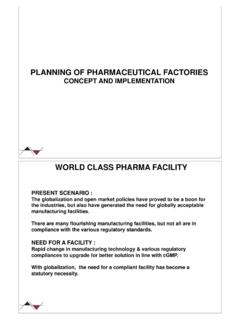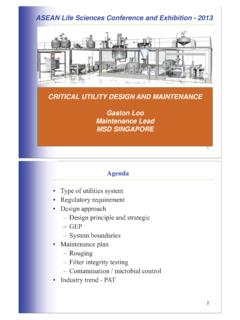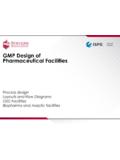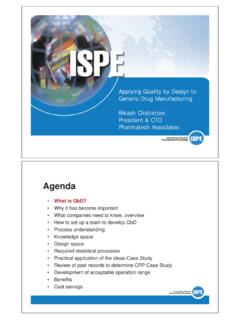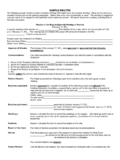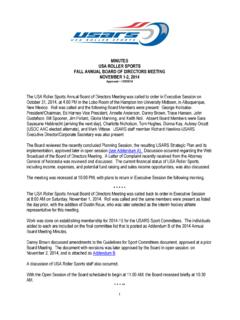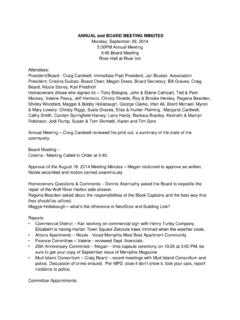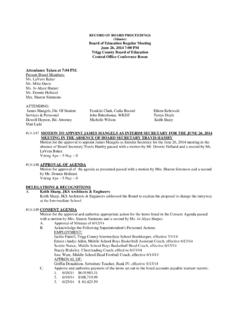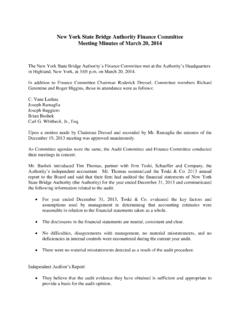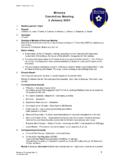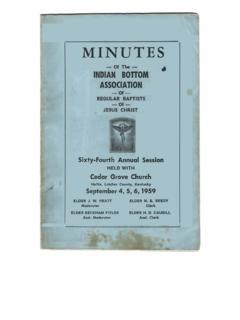Transcription of ISPE Thailand Annual Meeting Charlotte Enghave …
1 To view drawing guides: 1. Right-click on slide and select Grid and 2. Check Display drawing guides on screen 3. Select OK To view different slide layouts: Right click on the slide Choose Layout Trends in Sterile Manufacturing Technologies ISPE Thailand Annual Meeting Charlotte Enghave Fruergaard Where we come from 1930s Danish Novo and Nordisk Gentofte (later Novo Nordisk) employed the first engineers. 1974 Pharmaplan was founded as part of the medical care group by Fresenius, Germany. 1991 After functioning as in-house consultants at Novo Nordisk for years, NNE (Novo Nordisk Engineering A/S) demerged as an independent company. 2007 Acquisition of Pharmaplan, a company similar to NNE in DNA. NNE Pharmaplan was founded. With 80 years of experience we are passionate about our services to the pharma and biotech industries. Recent awards 2004 IChemE: Haden Freeman Award for Engineering Excellence 2005 ISPE Facility of the Year Award winner Novo Nordisk s NovoSeven (FVII) facility 2008 ISPE Company of the Year winner 2009 ISPE Facility of the Year Award winner Facility Integration hameln pharmaceuticals, Germany 2009 ISPE Facility of the Year Award winner Operational Excellence R&D division of US biotech company, Switzerland 2009 Emerson: PlantWeb Excellence for DeltaV application for Pronova BioPharma project (KalOmega) Text starts with no bullet Click once on Increase Indent for bullet and click up to three times for more bullet design To get previous design back, click on Decrease Indent Who we are We are the leading consulting and engineering company in the complex field of pharma and biotech.
2 We count close to 1,700 professionals with project experience and knowledge related to pharma and biotech. More than 200 have hands-on development or production experience. We executed 2,929 projects in 2012. Our project execution and our staff embody 10,000 years of experience within pharma and biotech Text starts with no bullet Click once on Increase Indent for bullet and click up to three times for more bullet design To get previous design back, click on Decrease Indent Optimal production processes Company revenue 2012 USD 294M EUR 224M DEVELOP ESTABLISH IMPROVE Project development Process & Product development Investment project CD / BD / DD / CON / C&Q Optimisation, training, revamps, GAP analysis, operational support Agenda Market changes forcing technology Aseptic/Sterile processes Technology Trends What is OSD and Biotech? Small Molecules vs. Large Molecules Chemical Synthesis Drying or Granulating Tableting Packaging Chemical Active Pharmaceutical Ingredient (API) Tablets Oral Solid Dosage Form (OSD) Formulation Fermentation or Cell Culture Inteferon molecule vs Aspirin Formulation Aseptic Filling Packaging Biologics Active Pharmaceutical Ingredient (API) Injectables Parenteral Dosage Form (aka Sterile Products) Small Molecules OSD Large Molecules Biotech Since 1899 Since 1982 Large Molecules grows faster Small Molecule drugs is the big market The Economist 2005 Shifting roles: The shift from small to large molecules became visible in 2003 Market changes forcing technology Products New products are more and more classified as high potent and require both a very high level of aseptic processing and operator / environmental protection Batch sizes Small batch sizes of very high value.
3 Based on better diagnostic methods, personalized treatment (1 vial = 1 batch) will increase Processes New products (mainly Biopharmaceuticals) are usually produced by aseptic processes Primary containers Pre-filled syringes and new developed devices are growing fast Automation Elimination of the human factor to avoid direct human impact for all critical process steps (class A operations) in a reproducible, validatable and documentable way Agenda Market changes forcing technology Aseptic/Sterile processes Technology Trends From API to Finished Product excl. QA/QC Finished Products API Components etc. Manufacturing of Sterile Products Wash & Sterilisation (incl. Comp. Prep.) Compounding (Preparation) Filling Barrier Isolator Lyophilizing Assembly & Packaging Assembly Labelling Packaging Filled units Logistics & Controls in Manufacturing Logistics Material Handling Inspection Controls Sterile Products Definition Sterile products are products free from living micro organisms Ph.
4 Eur. section Methods of Preparation of Sterile Products It is expected that the principles of good manufacturing practice will have been observed in the design of the process including, in particular, the use of qualified personnel with appropriate training adequate premises suitable production equipment, designed for easy cleaning and sterilisation adequate precautions to minimise the bio burden prior to sterilisation validated procedures for all critical production steps environmental monitoring and in-process testing procedures Sterilisation shall be done in the final container if at all possible Sterility Assurance Level (SAL) of minimum 1:1,000,000 Sterile or Aseptic manufacturing? Can the solution tolerate heat treatment? Yes Sterile manufacture Sterilization takes place in the end of the process (= terminal sterilisation) No Aseptic manufacture The solution is sterile filtered and thereafter only comes in contact with sterilised utensils and tanks in a classified environment (grade A/ISO 5 with a grade B/ISO 7 background) Filter pore size is m = mm Why do we have GMP?
5 Manufacturing of pharmaceutical products is all about Risk for the patient This is why we document, train and Traceability is being able to trace BACK especially when something goes wrong (batch numbers and documentation) Washing Process Purpose of washing Secure no leftover from previous product, no cross contamination Reduction of endotoxin and particles Items to be washed in a utensil washer Utensils Machine parts Hoses Typical process Rinse Wash with or without detergent Several rinse phases. Conductivity measurement Drying Sterilization Process Purpose of sterilization: Secure a product free of living microorganisms with a sterility assurance level of 10-6 or better Terminal sterilization Product produced at least in grade D and sterilized in final container Aseptic preparation Each primary packaging component sterilized individually Solutions sterile filtered All handling and filling of aseptically prepared products must be done in grade A/ISO 5 with grade B/ISO 7 background Items to be sterilized All items going to grade B/ISO 7 including sanitizers and gowning Methods of Sterilization Saturated steam 121 C, minimum 15 minutes, pressure + (Autoclave/SIP)
6 0,1 bar Hot water 121 C, minimum F0 15 minutes Dry heat sterilization 160 C, minimum FH 38 minutes Dry heat depyrogenation 250 C, minimum FH 15 minutes, lead to a 3 log reduction of endotoxin VHP sterilization Demonstrate a SAL of 10-6 Filtration Pore size < 0,22 m Radiation /e-beam A minimum dose of 25 kGy Liquid Compounding Preparation Liquid compounding of Sterile Products is mixing of Water for Injection (WFI) Active Pharmaceutical Ingredient (API) Other raw materials, Stabilisers (physical/chemical) Preservatives (if multiple use product) Isotonic substances Filling Process To take the sterile product from Compounding and fill it into a primary packing, which must protect the product and keep it sterile until use Multiple Batch Filling: Filling more than one batch between full cleaning/decontamination of the filling line During filling protection against contamination from the following must be avoided: The primary packing itself Surroundings & People Surroundings & People People are the most contaminating source for the product Why is this necessary?
7 Surroundings & People People are the most contaminating source for the product This must be reduced by protecting the filling process: Conventional Clean Room (CCR) Restricted Access Barrier System (RABS) Isolator Material Input/Output Glass Washing Sterilization Pistons Filling Product from Compounding Combi seals Filled and inspected Glass What are Barrier Systems? A physical barrier which separates the operator from the process. As important as the barrier itself are the linked features and processes such as: Properly designed equipment (ergonomics) and HVAC system Material transfer procedures Working procedures and training of the operators Procedures in terms of intervention and accidents That s why it is called a system Definitions CCR Conventional Clean Rooms (CCR) ISO 5 (class A) surrounded by ISO 7 (class B) room Pressure difference (15 Pa) between the clean room classes Critical operations with open sensitive products are carried out under Unidirectional Airflow (class A protection) Manipulations ( trouble shooting, change of format parts) are done directly by opening of the machine cladding Operator gets directly in contact with critical surfaces (class A area) Gowning of the operator according to class B requirements Material transition to class B (autoclave, pass box, dry heat oven)
8 Regular wipe sanitization Heavy routine viable monitoring Periodical room sanitization Machine parts pre-sterilized or disinfected in situ ConveyorVialNozzleFillingMechanismHEPA FiltersClass 100(ISO 5)3-6" FromHEPASC lass 10,000(ISO 7)PlasticcurtainsDefinitions RABS Restricted Access Barrier System (RABS) Surrounding clean room class B for the filling operation Pressure difference (15 Pa) between the clean room classes All manipulations during production are done via gloves of the RABS Ergonomic designed system for the process inside (Mock-up studies) Transfer of format parts via Rapid Transfer Port (RTP) Material transfer via Rapid Transfer Port (RTP) or material locks Gowning of the operator according class B requirements Conventional cleaning and disinfection Same viable monitoring as CCR Locked doors (barrier) during operation The system isolates the operator from the critical areas to increase Sterility Assurance Level (SAL) ConveyorVialNozzleFillingMechanismHEPA FiltersClass 100(ISO 5)3-6" FromHEPASC lass 10,000(ISO 7)PlasticcurtainsPassive ConveyorVialNozzleFillingMechanismHEPA FiltersClass 100(ISO 5)HVACC lass10,000(ISO 7)Doors withglovesActive Definitions Isolators Isolators ISO 5 (class A) inside isolator Surrounding clean room ISO 8 (class D or C) for the filling operation Positive pressure difference towards the filling room Ergonomic designed system for the process inside (Mock-up studies) Complete closed system with Vaporized Hydrogen Peroxide (VHP) decontamination of all surfaces Complete independent HVAC-unit All manipulations during production are done via gloves Gowning of the operator according class C or D requirements Material transfer via Rapid Transfer Port (RTP)
9 Or material locks Area to be monitored is very limited Very high SAL ConveyorVialNozzleFillingMechanismHEPA FiltersClass 100(ISO 5)AirReturnClass100,000(ISO 8)Doors withglovesThe Technologies Environment: B/A Complexity: Low Comfort: Low, due to clean room garment Aseptic quality: Low SAL~3 (*) Campaigning unusual Environment: B No overpressure to surroundings Complexity: High, due to transfer techniques and restricted access by gloves Comfort: Even lower, due to clean room garment and restricted access Aseptic quality: Slightly improved SAL~4 Several days campaign unusual Environment: D Overpressure Complexity: Highest, due to transfer techniques and biodecontamination Comfort: Medium, no clean room garment, but some restrictions Aseptic quality: Highest SAL~6 log Week(s) campaign possible Clean Room RABS Isolator Restricted Access Barrier Systems Barrier Systems Open RABS (active or passive) Conventional Clean Room Isolator Closed RABS (*) Sterility Assurance Level The Technologies Clean Room RABS Isolator Restricted Access Barrier Systems Barrier Systems Open RABS (active or passive) Conventional Clean Room Isolator Closed RABS (*) Sterility Assurance Level Currently most installed aseptic production lines are based on this Technology.
10 For new projects not anymore state-of-the-art . Rather new technology, with large increase in terms of installations within the past years. Since more than ten years developing quite fast, first in Europe, then also USA and Japan. First choice technology for handling of high potent APIs. Conflict of GMP vs. operator protection Pro and Cons CCR RABS Isolator Comments Validation, start-up risk Low Low High Complex isolator validation Necessity of experts Low Low High External consultants? Skill of personnel Medium Medium High Aseptic behavior needed in all 3 Investment, equipment Low Medium High Investment, building High High Low FMC high cost countries High High Low FMC elsewhere No real difference Suitability for campaigning Low Medium High Higher productivity with campaigning Sterility Assurance Level (SAL) Low Medium High Regulatory scrutiny High Low Low Risk SAL Media Fill High Medium Low Microbial Sampling Normal Normal Less Suitability for processing potent drugs Not given Limited Very good Maintenance complexity Low Medium High Access for service Easy Restricted Restricted Better for isolator due to garment Realization time Low Medium High Considerations Product Multi product production One product No of individual preparations per Year Containment Preservatives ?
